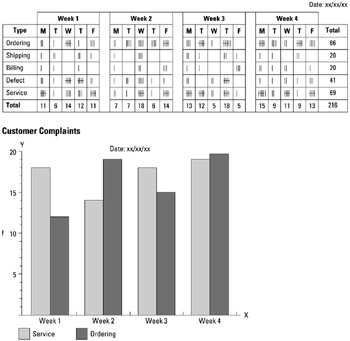Tool 14: Bar Chart
| AKA | Bar Graph |
| Classification | Analyzing/Trending(AT) |
Tool description
A simple bar chart is useful to present information for a quick problem or opportunity analysis. It provides a comparison of quantities of items or frequencies of events within a particular time period.
Typical application
-
To display a "snapshot" comparison of categories.
-
To depict the relationship between variations over time.
-
To illustrate process variability or trends.
-
To indicate a potential problem area (high or low frequencies).
Problem-solving phase
| → | Select and define problem or opportunity |
| → | Identify and analyze causes or potential change |
| Develop and plan possible solutions or change | |
| Implement and evaluate solution or change | |
| Measure and report solution or change results | |
| → | Recognize and reward team efforts |
Typically used by
| Research/statistics | |
| Creativity/innovation | |
| Engineering | |
| 1 | Project management |
| Manufacturing | |
| 3 | Marketing/sales |
| Administration/documentation | |
| 2 | Servicing/support |
| Customer/quality metrics | |
| Change management |
before
-
Data collection strategy
-
Frequency Distribution (FD)
-
Checksheets
-
Events log
-
Observation
after
-
Pie Chart
-
Stratification
-
Variance Analysis
-
Pareto chart
-
Presentation
Notes and key points
-
Care should be taken not to insert more than five bars or cover more than five time periods. This would make the Bar Chart cluttered and difficult to interpret.
-
f = frequency
Step-by-step procedure
-
STEP 1 Collect data from sources such as a checksheet. See example Customer complaints.
-
STEP 2 Construct a bar chart. Apply the 3:4 ratio rule. The height of the Y axis must be 75 percent of the length (100 percent) of the X axis.
-
STEP 3 Label the axes and insert the bars as shown in the exaple.
-
STEP 4 Check all information and date the bar chart.
Example of tool application

EAN: 2147483647
Pages: 326